The Official Ill Community Black History Thread
Options

Maximus Rex
Members Posts: 6,354 ✭✭✭✭✭
This isn't your typical Black History thread which talks about the ? were slaves and then jumps to the Civil Rights movement. Thread is meant to share gems that when share with the Dominate Society, it will shake to the core the things that felt they knew about society. I'll start things off by talking about Saint Augustine of Hippo.

St. Augustine of Hippo "The Knowledgeable One,"
St. Augustine (November 13, 354 – August 28, 430), also known as Saint Augustine or Saint Austin,[4] was an early Christian theologian and philosopher[5] whose writings influenced the development of Western Christianity and Western philosophy. He was the bishop of Hippo Regius (modern-day Annaba, Algeria), located in Numidia (Roman province of Africa). He is viewed as one of the most important Church Fathers in the Western Christianity for his writings in the Patristic Era. Among his most important works are City of ? and Confessions.
St. Augustine is among the four eminent Fathers of the Church and he helped formulate the doctrine of original sin and made seminal contributions to the development of just war theory. Many Protestants, especially Calvinists, consider him to be one of the theological fathers of the Protestant Reformation due to his teachings on salvation and divine grace. Before finding ? , as a youth Augustine lived a hedonistic lifestyle for a time, associating with young men who boasted of their bisexual exploits. The need to gain their acceptance forced inexperienced boys like Augustine to seek or make up stories about sexual experiences. As a result, St. Augustine is the patron saint of brewers, printers, and theologians. Augustine was also a major influence on the works of St. Thomas Aquinas.
St. Augustine was the son of St. Monica, who was born in Tagaste (present-day Souk Ahras, Algeria). She is believed to have been a Berber on the basis of her name. St. Augustine, Florida, (the oldest city in America,) is named after St. Augustine. Black Excellence

St. Augustine of Hippo "The Knowledgeable One,"
St. Augustine (November 13, 354 – August 28, 430), also known as Saint Augustine or Saint Austin,[4] was an early Christian theologian and philosopher[5] whose writings influenced the development of Western Christianity and Western philosophy. He was the bishop of Hippo Regius (modern-day Annaba, Algeria), located in Numidia (Roman province of Africa). He is viewed as one of the most important Church Fathers in the Western Christianity for his writings in the Patristic Era. Among his most important works are City of ? and Confessions.
St. Augustine is among the four eminent Fathers of the Church and he helped formulate the doctrine of original sin and made seminal contributions to the development of just war theory. Many Protestants, especially Calvinists, consider him to be one of the theological fathers of the Protestant Reformation due to his teachings on salvation and divine grace. Before finding ? , as a youth Augustine lived a hedonistic lifestyle for a time, associating with young men who boasted of their bisexual exploits. The need to gain their acceptance forced inexperienced boys like Augustine to seek or make up stories about sexual experiences. As a result, St. Augustine is the patron saint of brewers, printers, and theologians. Augustine was also a major influence on the works of St. Thomas Aquinas.
St. Augustine was the son of St. Monica, who was born in Tagaste (present-day Souk Ahras, Algeria). She is believed to have been a Berber on the basis of her name. St. Augustine, Florida, (the oldest city in America,) is named after St. Augustine. Black Excellence
Comments
-
Maximus Rex wrote: »Before finding ? , as a youth Augustine lived a hedonistic lifestyle for a time, associating with young men who boasted of their bisexual exploits. The need to gain their acceptance forced inexperienced boys like Augustine to seek or make up stories about sexual experiences. As a result, St. Augustine is the patron saint of brewers, printers, and theologians.
I dont get it?
Whats the ? stuff have to do with Brewers, Printers, & Theologians? -
-

That's my dad's book. It's the autobiography of the late Fela 'Anikulakpo' Kuti, originator of Afrobeat
I read it on my trip to Nigeria last year. Apparently Fela was a friend and confidante to my pops. They both lived in Lagos in the 70s.
My pops visited his Shrine for his shows and Fela called my pops to review or listen to his new joints
Ironically, in that book, Fela states that his whole idealogy later in life and his future militancy (musically and otherwise) came from reading The Autobiography of Malcolm X while touring in the States in the late 60s.. an American who's Black becoming an inspiration to a man who went on to become the greatest African musician in history
Fela now is sampled profusely by American rappers (who are mostly Black, LOL). Most recently by Lupe Fiasco. You see the cycle?
There's still hope for unity amongst Black people wherever and it can start on this forum.. -
Yo lemme sticky this thread, I'll contribute later
Damn, thanks dude. I curious to see what you'll contribute. -
Supposedly this is what inspired Gap Band Dropped the Bomb on me -
Really? Never knew thatFocal Point wrote: »
Supposedly this is what inspired Gap Band Dropped the Bomb on me
-
Tulsa stills ? me off.
-
Yea, 15,000 black people left homeless. Then eight years later the great depression began.Ajackson17 wrote: »Tulsa stills ? me off.
-
teach me somethin
-
Anyone that is really proud and appreciate their African heritage, and acknowledge all the successes, triumphs, hardships and every aspect of the history of being African-american knows that Black History Month isn't just a month
I respect what Carter G. Woodson did and what he started, at first beginning with "? History Week", and eventually turning into "Black History Month"
Those that truly appreciate and respect it, knows it doesn't start in February
It starts January 1st all the way to December 31st -
Focal Point wrote: »
Supposedly this is what inspired Gap Band Dropped the Bomb on me
Some people don't know that G.A.P. is an acronym for Greenwood, Archer and Pine Street in Tulsa which are apart of historical landmarks of Black Wall Street!
-
Ajackson17 wrote: »Tulsa stills ? me off.
That city is cursed, which is why they suffer the worse hurricanes. ? don't like ugly. -
aye IC fam. Can ya'll also drop some good books to check out?
-
Bartholomew_Jenkins wrote: »Ajackson17 wrote: »Tulsa stills ? me off.
That city is cursed, which is why they suffer the worse hurricanes. ? don't like ugly.
What thee ? ? Obviously you're not aware that Oklahoma is a land locked state that is bordered by Texas on it's southern border, New Mexico and Colorado to the northwest, (not Ye's little girl,) Kansas to the north, Missouri to the northeast, and Arkansas to the east. The nearest body of which is capable of producing hurricanes is the the Gulf of Mexico which is 822 miles away from Tulsa. ? really need to stay in school or at least study globes and atlases. Unless dude was confusing hurricanes with tornadoes. -
This is DOPE!!! I ll throw some ? in here....
-
“What he walks is like me walking to work every day and I honestly couldn’t believe that,” Leedy told ABC News. “I thought to myself, ‘What would I do if my car broke down?,’ and I thought, ‘I have my parents and I have money to get an Uber.’”
“This guy doesn’t have that and he didn’t quit,” Leedy said.
After reading the Detroit Free Press story on Robertson, Leedy saw in the comments that people were looking for a way to help so he started a GoFundMe page for Robertson, a complete stranger to him, within minutes of finishing the story.
“I initially set the goal for $5,000 just to get him something, bus fares and taxi rides,” Leedy said. “I went to go get ready and an hour later we had $2,000 donated already.
Leedy says he received a call from the corporate offices of Honda offering to donate a car, and a local Chevrolet dealership, Rodgers Chevrolet, has also already offered to give Robertson a car.
“We are in a position that we can help and we just want to pay it forward,” Angela Osborne, a customer service specialist at Rodgers, told ABC News. “His story really struck home.”
All the attention and donations are coming as a shock to Robertson, according to his friend and sometimes driver, Blake ? .
? , a vice president of wealth management at UBS, started seeing Robertson walking on his daily commute a few years ago. When Robertson cut through the parking lot of ? ’s office building one day two years ago, the banker stopped him.
? told ABC News he learned that Robertson walked most of his 20-plus mile commute daily, leaving his home in Detroit early each morning to get to work at a $10.55 per hour factory job in time for his 2 p.m. to 10 p.m. shift.
Robertson then does the reverse commute on the way home, having to walk even further because the bus lines on his route do not run at night, according to ? .
? estimates he has given Robertson close to 100 rides in the years since, even leaving his home at night to make sure Robertson gets home safely.
“I’m sitting in my warm house and I’m thinking this guy has five more miles to walk,” ? said.
? has also over the years taken friends who could not believe Robertson’s story along with him on rides to show that Robertson does indeed make that commute daily. Most amazing to ? is that Robertson, who could not be reached today by ABC News, “thinks nothing of it.”
“He’s said, “I can’t imagine people who don’t work. I can’t imagine not doing that,’” ? said. “Nothing gets him down. “If it’s rainy, if it’s cold, he just always says, ‘Hi Mr. Blake.’”
“I get to sit in the car and have that inspiration right next to me,” he said of Robertson, who began walking to work a decade ago when his then-car broke down.
Now ? is leading the charge to make sure that Robertson – whom ? says is not aware of the extent of the outpouring of support – benefits from the donations made in his name. Part of that effort includes establishing a group of community leaders and professionals who can help advise Robertson on the influx of money.
“We want to make sure that all of the wonderful contributions go to truly benefit James and not get wasted on other things or go to people who want to leech off of him,” ? said of Robertson, whom he says lives with his girlfriend and her family in a home she inherited from her mother.
“He deserves to feel good and he deserves to not walk 20 plus miles to work,” ? said. “We don’t want to change his life. We want to enhance his life.”
Leedy, who started the fundraising campaign, plans to meet Robertson, along with ? , for the first time in Detroit this evening.
“My vision now is to really help in any way,” said Leedy, who noted that GoFundMe officials have already contacted him with offers to help make sure 100 percent of the donations go directly to Robertson. “This could really change his life.”
“I want to talk to James first and know what his needs are,” Leedy said. “It’s not my money or my choice. I’m just facilitating the whole thing.”
- See more at: http://bossip.com/1098964/a-lil-positivity-donors-raise-over-145000-for-detroit-man-who-walks-42-miles-to-and-from-work-every-day/#sthash.AqExzNQn.dpuf -
 Ernest Wilkins Jr., worked on Manhattan Project, died at age 87
Ernest Wilkins Jr., worked on Manhattan Project, died at age 87
By Katie Drews May 9, 2011 10:04AM
At an age when many teen-age boys are chasing girls, J. Ernest Wilkins Jr. was chasing a Ph.D.
The Chicago native was only 13 when he enrolled at the University of Chicago, and by age 19 he had earned a doctorate in mathematics.
Mr. Wilkins, a prominent African-American scientist, engineer and educator whose 61-year career included work on the first atom bomb, died May 1of respiratory failure at his Arizona home, his son said. He was 87.
“Most people would argue that he was one of the most important scientists and mathematicians in the 20th century,” said Walter Massey, a physicist who is now president of the School of the Art Institute of Chicago. “His contributions were enormous.”
Mr. Wilkins was born in 1923 to Lucile Wilkins, a teacher, and J. Ernest Wilkins, an attorney who became the highest ranking African American in government when President Dwight Eisenhower appointed him assistant secretary of labor in 1954.
Growing up on the South Side, the younger Mr. Wilkins was the eldest of three boys, all of whom possessed such extraordinary intellect that teachers, unable to challenge them adequately, just kept skipping them to the next grade.
Mr. Wilkins started elementary school at 4 years old, reached fifth grade by age 7 and became valedictorian at his first graduation at age 10. He breezed through high school in three years and earned a scholarship to the University of Chicago, where he was the youngest student on campus.
“University of Chicago has high standards; it’s not like anybody just walks in,” said Robert Fefferman, dean of the physical sciences division at the U. of C. “This is the real thing, this person is really great.” The university was initially concerned about whether Mr. Wilkins could handle a college course load, but the child prodigy took on more than the required amount per quarter and graduated Phi Beta Kappa at age 16 with a bachelor’s degree in mathematics.
He finished his master’s degree a year later in 1941 and completed his doctoral dissertation, “Multiple Integral Problems in Parametric Form in the Calculus of Variations,” in 1942. According to African Americans in Mathematics, he was the eighth African American to have received a Ph.D. in mathematics in the United States.
Also at U. of C, Mr. Wilkins was known as a Ping-Pong “shark,” according to a 1941 issue of the Chicago Daily Tribune. The table tennis champ won multiple university titles and took first at a state competition.In his early 20s, Mr. Wilkins returned to U. of C. working as a physicist on the Manhattan Project, the name given to the federal government’s secret plan to develop the atomic bomb during World War II. His efforts in nuclear reactor physics included discoveries known as the Wilkins effect and the Wigner-Wilkins spectrum.
As a mathematician, Mr. Wilkins worked for a number of companies across the country, including American Optical Co., United Nuclear Corp., General Atomic Corp. and EG&G. He also went back to school at New York University for a bachelor’s and master’s degree in mechanical engineering.“He was just an outstanding physicist and still in an era in which an African American would not necessarily be hired into the same universities and hired in the same positions,” said his niece Carolyn Wilkins, author of Damn Near White, a book about the Wilkins family. “He faced a certain amount of racism, but at the same time he also accomplished a great deal.”
Later in life, Mr. Wilkins mentored students as a distinguished professor of applied mathematics and mathematical physics at Howard University and later at Clark Atlanta University.Ronald Mickens, a distinguished professor at Clark Atlanta, said Mr. Wilkins would often stand outside Mickens’ classroom door, listen to his lectures and return later with a 20-page detailed mathematical summary for the two to discuss. “He was a very creative person,” Mickens said. “In whatever issue or problem he dealt with, he was able to bring a unique, creative way of resolving it.”
Throughout his lifetime, Mr. Wilkins became “a black first” in so many areas that everyone in the family stopped counting,” according to Damn Near White. He published more than 80 research papers, served as president of the American Nuclear Society and won multiple awards such as the National Association of Mathematics Lifetime Achievement Award. According to his son, Mr. Wilkins did not talk much about work at home — mostly because no one understood it. J. Ernest Wilkins III remembers throwing outrageous and complicated math questions at his dad, who would always grumble, “Who cares?”
However, later Mr. Wilkins would always return with the answer.
The last question the son asked his father was, “How many zeros are in a googleplex?” This time he never got an answer.
“He said, ‘I don’t care!’ ” the son recalled with a laugh. “That’s what I will miss most about Dad.”
Aside from his son, Mr. Wilkins is survived by his daughter Sharon Wilkins Hill, three grandchildren and two great-granddaughters.
Services have been held.
ObituaryChicago.com
http://www.suntimes.com/news/obituaries/5259361-418/ernest-wilkins-jr.-worked-on-manhattan-project-died-at-age-87
http://www-history.mcs.st-and.ac.uk/Biographies/Wilkins_Ernest.html
http://www.maa.org/programs/underrepresented-groups/summa/summa-archival-record/j-ernest-wilkins -
Cruikshank Case (1876)

Governor of Louisiana from 1873 to 1877, Vermont native William Pitt Kellogg was the state's last Republican governor until 1980.
Abraham Lincoln’s Gettysburg Address in November 1863, along with Reconstruction’s three amendments, gave the country a fundamentally new constitution. The Thirteenth (1865), Fourteenth (1868), and Fifteenth (1870) Amendments abolished slavery, gave black males civil rights and the vote, and, more importantly, established a national citizenship whose rights, protected by the federal government, were to be enjoyed by all Americans. But the US Supreme Court—beginning in 1873 with the Slaughterhouse decision and continuing with the Cruikshank decision in 1876—restricted the rights protected under these amendments. The United States v. Cruikshank case arose from the Colfax Massacre, the bloodiest act of terrorism during Reconstruction.
McEnery, John ¬ Photoprint ¬ Head and shoulders portrait. Many Louisianans considered Democrat John McEnery the winner of the 1872 gubernatorial election. Controversy after the election, however, eventually resulted in a victory for Republican candidate William Pitt Kellogg.
Colfax Massacre ¬ Illustration ¬ "Massacre of the Negroes at Colfax Court House" This 1873 illustration shows a scene from the Colfax Massacre, an onslaught by an armed white militia against freedmen and black state militia members. When black citizens held a meeting at the Colfax courthouse to discuss the contested outcome of the 1872 governor's race, the white militia attacked, killing between 60 to 250 people; three white militia members also died.
Colfax Massacre ¬ Illustration ¬ "The Louisiana Murders" An illustration from Harper's Weekly magazine entitled “The Louisiana Murders” depicts a scene from the aftermath of Colfax Massacre in 1873.
The Situation
Louisiana’s 1872 gubernatorial election produced two rival claimants for the office: Democrat John McEnery and Republican William Pitt Kellogg. President Ulysses S. Grant and his administration declared Kellogg the rightful claimant. But the election, full of fraud and intimidation, incited turmoil all over the state. In the small village of Colfax, 220 miles northwest of New Orleans, a Democrat and a Republican each claimed to have won the office of sheriff. Kellogg sent rifles to the Republican claimant in order to arm his black followers. The Democratic claimant and his supporters, all white, launched an attack on the Republicans as they conducted a meeting in the courthouse. When the Republicans inside refused to stop the meeting and leave, the Democrats torched the building. Many died, and those who fled were shot. The twenty or so who survived the fire and the shootings were jailed.
The next night even those survivors were killed in cold blood. No one is certain how many black men died; the number ranges from a low of 60 to a high of 250. In 1950 the Louisiana Department of Commerce and Industry installed a plaque that reads, “On this site occurred the Colfax Riot in which three white men and 150 Negroes were slain. The event on April 13, 1873 marked the end of carpetbag misrule in the South.” The message engraved on a twelve -foot-tall marble obelisk in the Colfax white cemetery provides a more accurate description of the motivation for the violence: “In loving remembrance/Erected to the memory of the [three] heroes … who fell in the Colfax Riot fighting for white supremacy. April 13, 1873.”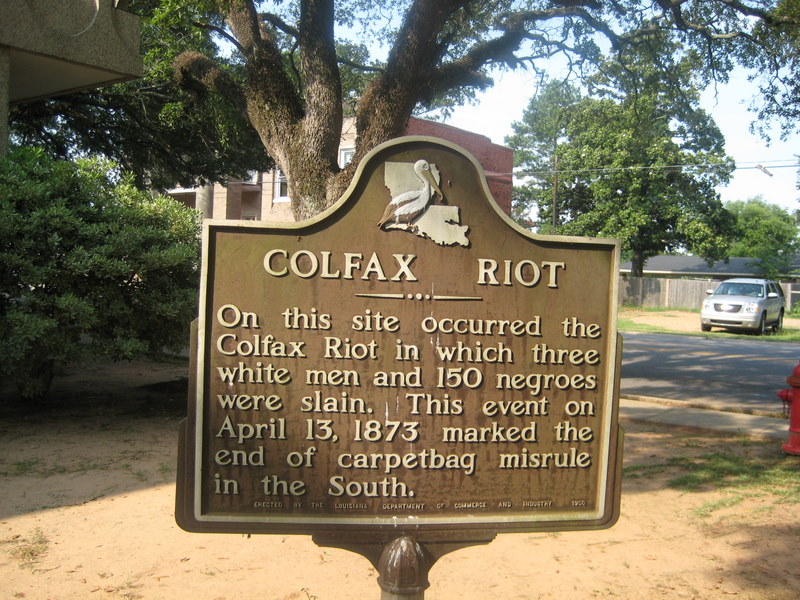
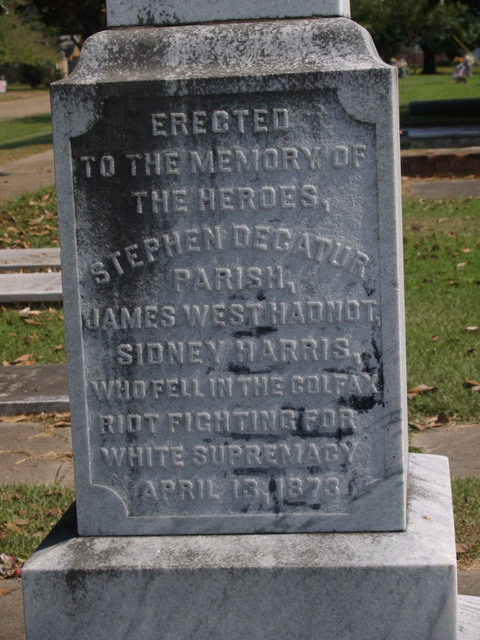
https://friendsofjustice.wordpress.com/2008/10/27/the-cruel-grip-of-history/
The Trial
Nine white men, accused of having taken part in the massacre, were arrested and put on trial in federal court in New Orleans. They were charged not with murder but with having deprived the murdered men of their civil rights, as enumerated in the Enforcement Act of 1870. After an initial mistrial, a second trial convicted four of the nine men, including William B. Cruikshank. The conviction was appealed and heard by the US Circuit of Appeals. Because the circuit court judges disagreed over the matter of guilt, the case went to the US Supreme Court.
Finally, on March 27, 1876, almost three years after the massacre, the convictions of Cruikshank and his companions were reversed. Chief Justice Morrison Waite issued the majority opinion. He began with a general statement of principles, citing the Slaughterhouse case: “The same person may be at the same time a citizen of the United States and a citizen of a state.” Then he went on to say that the Fourteenth Amendment gave Congress the power to prohibit states from denying life, liberty, or property without due process of law, but the Colfax murders had been the work of private parties, not the state of Louisiana. The implication was that this case should have been left for adjudication within the court system of Louisiana.
Result
The Cruikshank decision left the federal government all but powerless to protect freedmen, except by the use of troops—and these troops had to be requested by the state legislature or the governor. In fact, James R. Beckwith—US attorney for the District of the Circuit Court of Louisiana and the person who had drawn the initial indictment in the Cruikshank case—wrote to inform the US attorney general that after the Cruikshank matter, various White League organizations in the South had sprung to life and grown influential precisely because of this decision.
The Enforcement Act and its proposed application in the Cruikshank case posed a classic instance for which the Fourteenth Amendment and enforcing legislation was devised. The states had defaulted in their duty to protect citizens, so the federal government had to step in. Yet the court argued that the Reconstruction era amendments only empowered the federal government to prohibit violations of blacks’ rights by states; the responsibility for punishing crimes by individuals rested where it always had—with local and state authorities. The Cruikshank decision therefore gave a green light to acts of terror wherever local officials either could not or would not enforce the law.
Written By Carol Gelderman, University of New Orleans
http://www.knowla.org/entry/1581/ -
Great thread my Lybians
-
-
The African Popes
The African popes in question are said to have come from the North African area that is present-day Algeria, Mauretania, Numidia, and Tunisia. Historians name this area the maghreb. Today it is mostly Muslim. The indigenous people of North Africa are Berbers, brown skinned as among the Tuaregs and Algerians.
Pope St. Victor
Pope St. Victor I (reigned 189-199) worked to settle a dispute among the bishops of the East and West over when to celebrate Easter – known as the Quartodeciman controversy. The other bishops recognized his unique authority when they followed his directive to convene local and regional synods to deliberate on the issue. Most of the bishops decided to adopt his proposal that the whole Church celebrate Easter on the first Sunday after Passover. Those who didn’t, he threatened with excommunication. The fact that no bishop in the world — not a single one — disputed his authority as bishop of Rome to carry out such an excommunication is a powerful piece of evidence that the early Church recognized the unique authority of the bishop of Rome.
It needs to be noted that some historians puts the start of the reign of Pope St. Victor with the first year of Septimius Severus (one of the African Emperor of Rome.) So at one point in time the two most powerful men in the world, one who controlled the known Western world from present day Britain to present day Iran and the other who was a later of large religious sect were black men. That's not black excellence, that's black dominance. Also Pope St. Victor decided on when Easter would be celebrated.
Pope St. Miltiades
Constantine presented the pope with the Lateran Palace, which became the papal residence and seat of Christian governance. Early in 313, Constantine and fellow Emperor Licinius reached an agreement at Milan that they would grant freedom of religion to the Christians and other religions and restore church property.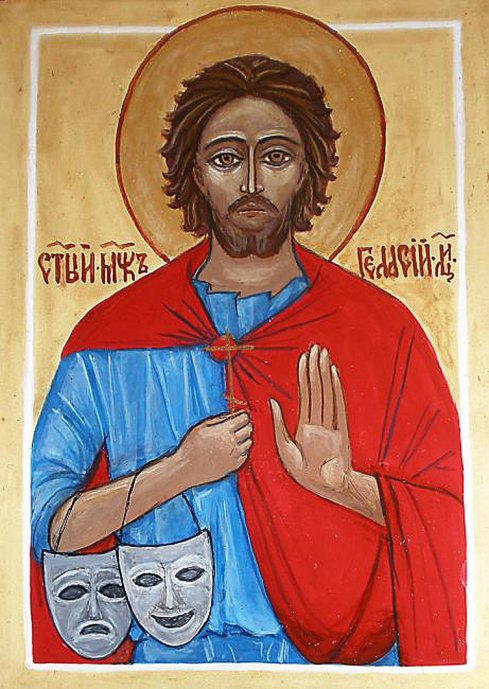
Pope Gelasius I
Was known was a prolific writer whose style placed him on the cusp between Late Antiquity and the Early Middle Age. He first pope to be called the Vicar of Christ, he proposed that spiritual and temporal powers are separate trusts from ? .
-
First Class by Alison Stewart
"Dunbar High School in Washington, DC, defied the odds and, in the process, changed America. In the first half of the twentieth century, Dunbar was an academically elite public school, despite being racially segregated by law and existing at the mercy of racist congressmen who held the school’s purse strings. These enormous challenges did not stop the local community from rallying for the cause of educating its children. Dunbar attracted an extraordinary faculty: one early principal was the first black graduate of Harvard, almost all the teachers had graduate degrees, and several earned PhDs—all extraordinary achievements given the Jim Crow laws of the times.
Over the school’s first eighty years, these teachers developed generations of highly educated, high-achieving African Americans, groundbreakers that included the first black member of a presidential cabinet, the first black graduate of the US Naval Academy, the first black army general, the creator of the modern blood bank, the first black state attorney general, the legal mastermind behind school desegregation, and hundreds of educators.
By the 1950s, Dunbar High School was sending 80 percent of its students to college. Today, as with too many troubled urban public schools, the majority of Dunbar students struggle with reading and math. Journalist and author Alison Stewart, whose parents were both Dunbar graduates, tells the story of the school’s rise, fall, and path toward resurgence as it looks to reopen its new, state-of-the-art campus in the fall of 2013." (Melissa Harris-Perry)
http://www.amazon.com/First-Class-Legacy-Dunbar-Americas-ebook/dp/B00DKMP1HC -
Powerful
-

BlackHistoryMonth - fun fact: Sanford & Son killed #TheBradyBunch. Dig this! In '74, both shows were on Fridays @8pm. Sanford slayed Brady in the ratings so bad...ABC pulled the plug -
For almost 80 yrs black people were no longer slaves but instead forced to labor against their will.. It forced blacks into a state of slavery without the label of it.. ? they did to black people like peonage were some of the worst ways they repressed them. The last slave was held captive until the 1940s.. Our country's history is pretty sicking.. and how about them pig laws.. really 5 yrs in prison 4 steeling a 50 cent pig. .



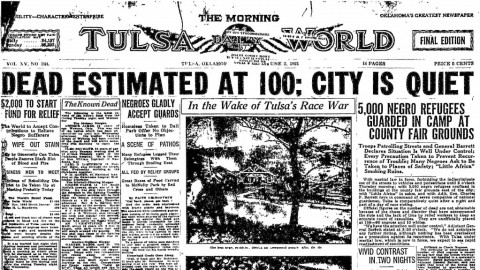
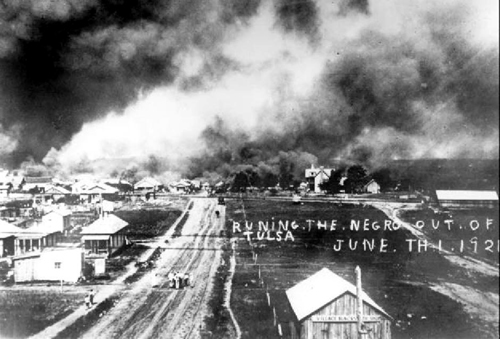










 https://youtube.com/watch?v=Ffmg6i0lv_k
https://youtube.com/watch?v=Ffmg6i0lv_k
 https://www.youtube.com/watch?v=_uomF1a8e9w
https://www.youtube.com/watch?v=_uomF1a8e9w